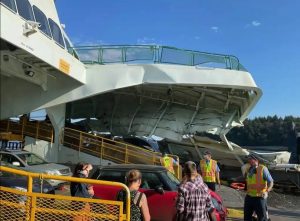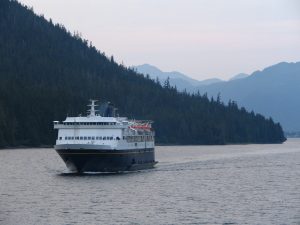Ferries operate around the world, most of the time successfully enough. Here in the Puget Sound area, millions rely on ferries each year. In fact, according to the Washington Department of Transportation, over 75,000 commuters use the ferry system each work day, and vehicles board ferries around 11 million times per year for work and leisure, making our ferry system the largest in the U.S. and the third largest in the world.
Ferry collisions, allisions, and casualties are rare in Puget Sound, but, unfortunately, such incidents are not so uncommon around the world. The latest is a horrible tragedy involving the lives of hundreds of high school students on a field trip, as well as many other people aboard for the usually safe 13.5 hour journey between Incheon and Jeju, South Korea.
This ro-ro (roll on/roll off) ferry, SEWOL, was built in Japan in 1994, and started her life ferrying passengers there as NAMINOUE MARU. She is 481 feet long, 72 feet abeam, with a maximum speed of 22 knots. In 2012, she was bought by a Korean marine company and refitted with more passenger deck space, with increased her maximum capacity to 956 persons. Different sources cite a car capacity ranging between 90 and 200, in addition to space devoted to semi-trucks and TEU containers. SEWOL passed more than one safety and insurance inspection for the new additions and weight increase, was pronounced seaworthy, and was set on the Incheon-Jeju route.
On April 16, there were 476 people known to be on board SEWOL. According to reports, 339 of these people were high school students from Danwon High School in Ansan, which is not too far from Seoul, along with some of their teachers. The rest of the people were passengers on other business, and crew. About 16 miles from shore off the southern tip of South Korea, shortly before 9:00 a.m. KST, in calm weather, SEWOL made a hard turn and began to list. Minutes later, a loud noise reverberated. Whilst most of the passengers obeyed the captain’s instructions to remain in their quarters, SEWOL listed ever farther to port, eventually to a degree which removed all hope of evacuating those passengers. By the time the captain made the call to abandon ship, about an half-hour after that hard turn, the intercom system no longer functioned. Good Samaritans in the area and arriving rescue workers saved as many people as they could find, as the SEWOL beam listed perpendicular to the sea, trapping students and other passengers inside. SEWOL took over three hours to sink completely into seas where SAR divers report visibility to be mere inches in front of their faces.
Continue reading
 The U.S. Coast Guard from the Puget Sound sector was deployed on Thursday morning, July 28th at about 8:20 a.m. after the Washington State Ferry CATHLAMET crashed into the pilings near the West Seattle Fauntleroy dock. It is reported that the vessel had veered off course and was coming in too fast at the time of the crash. One car was reported to be pinned inside the ferry after the top side section of the ferry crumpled from the impact.
The U.S. Coast Guard from the Puget Sound sector was deployed on Thursday morning, July 28th at about 8:20 a.m. after the Washington State Ferry CATHLAMET crashed into the pilings near the West Seattle Fauntleroy dock. It is reported that the vessel had veered off course and was coming in too fast at the time of the crash. One car was reported to be pinned inside the ferry after the top side section of the ferry crumpled from the impact. Maritime Injury Law Blog
Maritime Injury Law Blog


